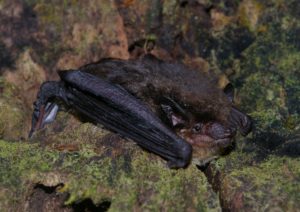
Hi everyone! I hope you all had a good week! I’m excited because it’s almost Christmas! I found a very interesting article about a group of scientists in Uruguay who are creating a special AI algorithm that will help in identifying bats flying around! This is important because bats in South America speak different dialects than the same species in North America. So, the databases in use in North America don’t work in Uruguay or the rest of South America. This new algorithm will be able to pick up a bat’s call through a microphone and determine which species it is. This algorithm was first created to help scientists learn which bats were flying into windmills. This information could then be used to work with wind farm operators to help protect bats. Studies have shown that more than 40 bat species are affected by windmills and almost 300 mass bat death events have occurred due to wind turbine blades. Until now, scientists needed to catch bats flying in an area in order to identify them. With this algorithm, the very difficult and time-consuming task of catching a bat is no longer necessary. In addition to being used to help scientists protect bats from wind turbines, this algorithm could be used to identify unknown bat species. Hopefully the use of this algorithm will help scientists locate a bat that has been believed extinct in Uruguay for 50 years. If you would like to read more about this study, you can find information here. .
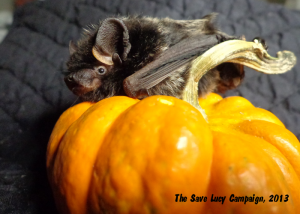
Hi everyone! I hope you all had a good week. My week started with my dog’s birthday. We’ve been celebrating and spoiling her all week. Yesterday, there was an earthquake in Alaska. I decided to research an Alaskan bat. I found an adorable bat called the Silver-haired bat. The Silver-haired bat lives in the temperate rain forests of Southeast Alaska. Actually, these bats live throughout the United States, including Save Lucy’s state of Virginia, and southern Canada. The Silver-haired bat has black fur all over its body except for their ears. The black fur on their back has silver tips which makes the bat look like it has a back full of silver fur. These bats also have short round and hairless ears that lay close to their head. Like all bats in North America, these bats are insectivores. They love to munch on an assortment of meals such as flies, moths, mosquitoes, beetles, ants, and crickets. Silver-haired bats like to roost near water in areas near lakes, ponds, and streams. They roost here because they hunt close to the water where there is an abundance of tasty bugs for them to crunch on. They roost in tree foliage, under loose bark, and sometimes buildings. They like to hibernate under loose bark and in tree hollows. If you would like to learn more about the Silver-haired bat, you can read about them here and here.
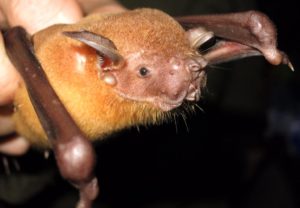
Hi everyone! I hope you all had a good week! I did because we got a snow day on Wednesday. We got about an inch of snow before it started sleeting. The wonderful people in charge decided that it wasn’t safe for us to go to school. It was wonderful! It was glorious! And then to add to the gloriousness, we got a 2 hour delay the next day! It was great! I hope everyone else enjoyed their snow days as much as I did. I was looking up interesting bat species and I found one called the Bulldog Bat. I think this bat is really cute. Of course, all bats are cute, but I might be a little biased toward this one because it looks a little bit like my pug. The name Bulldog Bat actually is used to describe two different species of bats that live in Central and South America. These bats hunt over water. As their name suggests, these bats have big lips and a flat squarish muzzle that makes them look like a bulldog. They also have cheek pouches that they use to store food in. These bats have very large hind feet with hooked claws. They use their claws to catch prey from the surface of the water. The Lesser Bulldog Bat eats mostly insects. The Greater Bulldog Bat eats fish. Once they catch their prey, they chew their food and store it in their cheek pouches to finish later. The Lesser Bulldog Bat uses echolocation to find its prey. The Greater Bulldog Bat skims the top of the water echolocating on ripples made by the fish. One problem the Bulldog Bat has with hunting over water is that they get wet wings, however these bats actually have an oily substance coating their wings […]
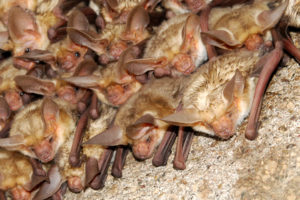
Hi everyone! I hope you all had a good week! People in California have been having a hard time. They are having some really bad wildfires again. This week’s blog is dedicated to all the people in California affected by these fires. I found a handsome bat that lives in California called the Pallid Bat. I think I have written about this bat before, but it is so cute that I thought it would be nice to read about them again. This bat also lives in British Columbia all the way down to central Mexico. They also live as far east as western Texas, Oklahoma, and southern Kansas. The Pallid Bat is found in deserts, rocky places, oak and pine forests, and farmland. These bats like to roost in caves, rock crevices, mines, hollow trees, and buildings. These adorable bats have light brown fur with pale white fur on their stomachs. They have special glands on their face, much like the glands of skunks. The glands produce an odor just like a skunk’s too. They use this odor to defend themselves. The Pallid Bat has an amazing adaptation. Unlike most bats, the Pallid Bat does not eat their food while flying. They land and then eat! They swoop down on their pray, and then carry their meal to a safe perch where they can eat it. These bats feast on crickets, beetles, grasshoppers, and scorpions. Most North American bats aren’t big enough to safely take down a scorpion, but these fluff balls are actually immune to a scorpion’s sting. [And they pollinate cactus! Researchers noted that pallid bats netted near columnar cactus were often covered in pollen, but it was assumed they were picking up pollen while gleaning for insects. Researchers studying the plant interactions of another bat, the nectar […]
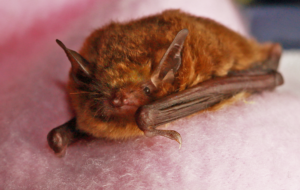
Hi everyone! I hope you all had a good week. I had a rough ending to my week because I sprained my ankle very badly. I was viciously attacked by a tree root and my ankle did not appreciate it. Even though I am wounded, I think I had a better week than a lot of people in the southeastern part of the country. Hurricane Michael tore through the area last week and people there are still suffering. This week, I researched another Florida bat and I think I found a cute one. The Southeastern Myotis is adorable! It looks a lot like Little Brown Bats. They have gray-brown to orange-brown fur and are lighter on their stomachs. Their fur, however, is shorter, and thicker, than that of the Little Brown Bat. Southeastern Myotis live in many other places than Florida. They also live in Southern Illinois and Indiana, Oklahoma, western Tennessee, Arkansas, Northeastern Texas, the southern part of North Carolina, the Ohio River Valley of Kentucky, and coastal regions northward into Virginia. The Southeastern Myotis likes to roost in caves, hollow trees, buildings, and bridges. They eat insects, such as mosquitoes, flies, small beetles, and moths. If you would like to read more about the Southeastern Myotis bat, you can find information here. Also, I would like to remind everyone of the big batty event at the US Botanic Gardens in Washington, DC next weekend. The Bat Bonanza Event will be Saturday, October 27 and will begin at 10 AM. This is always a very fun event full of all kinds of batty fun. I plan on being there and, best of all, Mrs. Sturges, Save Lucy’s President, will be there with some live bats. If you are in the DC area, I hope you’ll stop by.
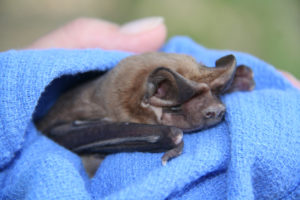
Hi everyone! I hope you all had a good week. Mine was fun because I have a friend visiting, so I’ve been doing a lot of sightseeing. There was a hurricane in the southeastern United States this week. The state of Florida was hit very hard. This week’s blog is dedicated to everyone affected by Hurricane Michael, not only in Florida, but also in Alabama, Georgia, North and South Carolina, and Virginia. I did a little bit of research and discovered that Florida’s largest bat is the Florida bonneted bat. I wrote about this bat a couple of years ago, but I thought it was worth refreshing everyone’s memories on this adorable bat. This bat is listed as endangered by the USFWS and is believed to be the rarest bat in the world. The Florida bonneted bat is large with a long tail membrane. It can be 6.5 inches long with a wingspan of 20 inches. Its ears join at the base. The bats’ fur is black, brown, gray, or cinnamon brown. Not much is known about this bat because it is so rare. They only live in a few counties in south Florida and only a few nursery roosts have been found. Loss of habitat is the Florida bonneted bats’ greatest threat. Habitat loss for this species comes in the form of human destruction of its roosting sites as well as natural disasters such as hurricanes. If you would like to read more about the Florida bonneted bat, you can find information here. In other batty news, there will be a bat event at Huntley Meadows Park in Alexandria, VA tonight at 7:00 PM. I am going to try to make it. Mrs. Sturges will definitely be there with some of our bat friends. If you are in the […]
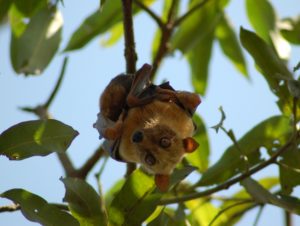
Hi everyone! I hope you all had a good week! Things went from bad to worse in Indonesia this week. After having both an earthquake and a tsunami last week, a total of three volcanoes erupted this week. These volcanoes are spewing ash into the sky, which makes it difficult to breathe. Once again, I would like to dedicate my blog to the people of Indonesia. I hope things improve for you all very soon. Our esteemed leader, Mrs. Sturges, suggested that I write about the Sulawesi flying fox. The Sulawesi flying fox lives on the islands of Sulawesi and Buton. Sulawesi is the island where there was the earthquake and tsunami. This adorable flying fox has yellow-orange fur and long noses that are perfect for munching on fruit and sucking up pollen. They have big eyes compared to microbats. Sulawesi flying foxes like to eat coconuts, breadfruits, and their favorite, pollen from eucalyptus blossoms. Like a lot of other megabats, Sulawesi flying foxes roost in trees. They are often found hanging in mangrove forests. These bats will sometimes share the trees that they are roosting in with black flying foxes. It works out perfectly for the bats because black flying foxes prefer lower branches and Sulawesi flying foxes like to be up high. Sadly, these bats are listed as vulnerable because of hunting. A lot of Sulawesi roosting trees are being cut down which leaves them unprotected. Sulawesi flying foxes are completely extinct in North Sulawesi because of the hunters. If you would like to read more about the Sulawesi flying fox, you can find information here. I would like to remind everyone that there is another batty event on Saturday, October 13 at 7:00 PM. This event will be at Huntley Meadows Park in Alexandria, VA. Mrs. Sturges […]
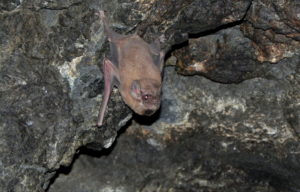
Hi everyone! I hope you all had a good week. My week had a sad start because the Nature Fest in Herndon was cancelled because of the rain. It rained pretty much all week, but I think we are supposed to have a sunny weekend. There was another earthquake in Indonesia on Friday. And then after the earthquake there was a tsunami. I would like to dedicate this week’s blog to the people of Indonesia. My thoughts are with you all while you recover from these events. I researched Indonesian bats and I found an absolutely adorable one! It is called the Black-bearded tomb bat. They have a face that reminds me of a shrew with a beard. Its face points outward and they have big round ears on top of their head. Their fur is brown with a little bit of gray and sometimes even red. The dense fur covers most of their body, but it stops before it covers their face. I think this makes their fur look slightly mane-like. The male Black-bearded tomb bats have seasonal black-ish brown beards that they grow to attract mates. Black-bearded tomb bats are found in a variety of places including Indonesia, China, India, Malaysia, Singapore, Vietnam, and Thailand. They roost in rainforests, woodlands, and abandoned buildings. They roost near where they can find their favorite foods. They eat insects like many other bats, but they also enjoy munching on fruit. If you would like to learn more about these bats, you can find information here and here.
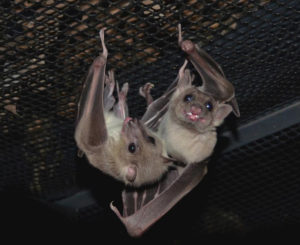
Hi everyone! I hope you all had a good week. I was looking up interesting bats from around the world and found a really adorable one called the Rousettus Bat. Rousettus bats are also more commonly known as Egyptian Fruit Bats. These bats have orange-yellow fur around their necks that match nicely with the dark brown and gray fur along their backs and stomachs. Rousettus bats are found in the tropical rainforests, savanna, and tropical deciduous forests in Africa. They are also found in scrub forests of Mediterranean Turkey. Egyptian Fruit bats eat a lot of fruit each night. They like to eat soft, pulpy fruit, especially wild dates. They also eat unripe fruit and fruit damaged by insects or fungus. Because they eat this fruit, they are able to survive when ripe fruit is not available. If you would like to read more about the Rousettus bat, you can find information here. And now for the exciting news! Herndon Nature Fest is tomorrow afternoon from 1 – 5 PM. It is being held at Runnymede Park, 195 Herndon Pkwy in Herndon, VA. Save Lucy’s President, Mrs. Sturges, will be there with some bats and I will be there too! If you are in the area, I hope to see you there. Have a good week!
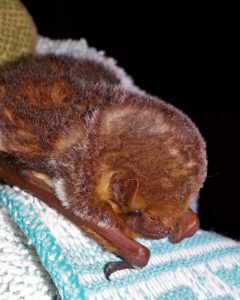
Hi everyone! I hope you all had a good week. Mine was pretty good. People in the Carolinas are having a really hard time though. Hurricane Florence made landfall yesterday and is causing a disaster in North and South Carolina. This week’s blog is dedicated to the people of North and South Carolina. I hope they are able to stay safe during the storm and are able to return to their homes soon. I researched a bat that lives in the Carolinas. It is an adorable bat species called the Seminole bat. The bats are found in a wide range. They live in the forested regions of eastern Texas, north to southeastern Oklahoma, central Arkansas, Mississippi, Tennessee, Georgia, North and South Carolina, and into south-central Virginia. And, if you’ll remember, there were a few Seminole bats found in Northern Virginia not too long ago. These furry little critters have an interesting place that they like to roost. They roost in Spanish moss! They also like loose tree bark that they can squeeze under. A lot of their roosts are in dark locations where they can drop down into flight. The Seminole bat has mahogany colored fur with silver-ish tips that give the bats their beautiful reddish coloring. The Seminole bat eats insects. They especially like leafhoppers, flies, beetles, bees, and ants. If you would like to read more about these bats, you can do so here.









